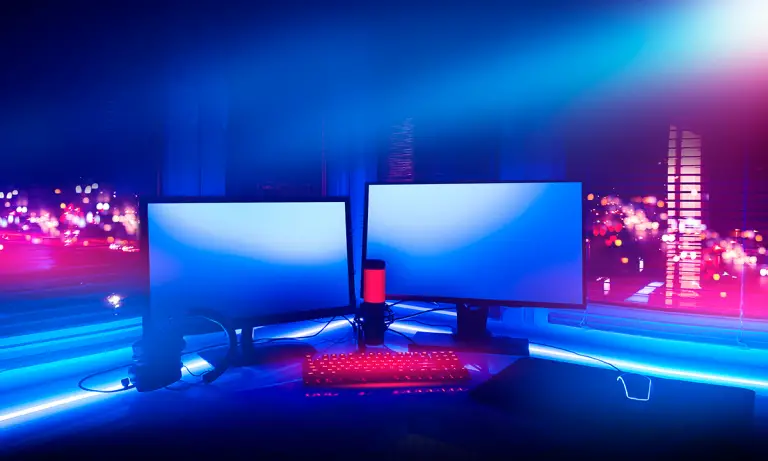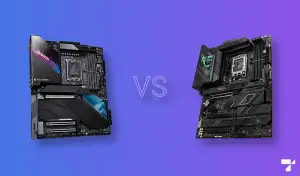The best and most powerful computer won’t get you anywhere unless you have a great monitor to pair it with that is suited to your specific needs. With that being said, we can rightfully say that your monitor is an integral peripheral to having a good overall computing experience.
When it comes to buying the perfect monitor, there are a lot of decisions to be made, and one of the most important factors is the size of the monitor. More specifically, 24 vs 27-inch monitors are the two most popular monitor sizes when it comes to computing. Therefore, we have created this detailed comparison guide to help you decide if a 24 or 27-inch monitor is best for you.
24 vs 27 Inch Monitor
Generally speaking, 24-inch monitors are ideal for 1080p resolution. While 27-inch monitors are ideal for 1440p and even 4K resolutions. This is especially true for gaming and other graphically intensive tasks. This is largely due to pixel density as 1440p and 4K resolutions are too dense for 24-inch monitors and 1080p is not dense enough for larger 27-inch monitors leading to poorer image quality. It is also important to note that 24inch monitors are considerably cheaper than 27-inch monitors.
Therefore, it all comes down to your budget and your requirements when deciding between a 24 inch vs a 27inch monitor. If you’re buying a monitor for graphically intensive tasks such as graphic designing or high-end gaming then opt for the 27-inch 1440p or 4K monitor. But, make sure your GPU can support that 1440p or 4K resolution. It is not worth buying a high-resolution monitor such as 1440p or 4k if your computer is not running a graphics card capable of handling those resolutions at 60 FPS or greater and vice versa. However, if you’re just a casual gamer, on a budget, or don’t plan to do much visually intensive work such as graphic design, then a good 24-inch 1080p monitor would suffice.
Monitor Dimension and Resolution
We must discuss the relationship between monitor dimensions and resolutions. When it comes to picking up a monitor of a certain dimension or size such as 24 inches or 27 inches, the resolution of that monitor has a major role to play in outputting a crisp, detailed, and clear image.
The resolution for a particular monitor size is not set in stone. A monitor of a particular dimension can have multiple resolutions. For example, a 27-inch monitor can have a 1440p resolution while another 27-inch monitor can have a resolution of 1080p. It is also important to note that 1080p and 1440p are the most popular monitor resolutions, especially for gaming. Though 4K is gaining more popularity among users as they become cheaper and more capable GPUs are released.
Pixel Density
A pixel could be thought of as a building block of an image. Everything you see on a screen comes down to a pixel. Pixels, work using the golden rule of thumb, and that is more the better. This is where the term pixel density is derived. Pixel density is the number of pixels per inch of the screen, commonly known as PPI (Pixels Per Inch).
Pixel density is dependent on the size of the screen, its resolution, and lastly the type of screen. A 24-inch 1080p screen has a pixel density of approximately 92 PPI, whereas a 27-inch 1440p screen has a pixel density of approximately 112 PPI. This makes the 27-inch 1440p monitor the considerably better choice but at a higher cost. A monitor having a low pixel density will show you a comparatively pixelated or less clear image when compared with a high pixel density monitor.
As far as the screen types are concerned, the most recent OLED screens offer the best PPI. IPS and VA panels are also very good. However, TN screens on the other hand offer the lowest PPI amongst the other screens available in the market, but they do have the advantage of being cheaper.
Cost Differences Between 24 and 27 Inch Monitors
As mentioned above, a 27-inch 1440p monitor is way ahead of the game when it comes to pixel density and overall image quality. But because of this, It is however considerably more expensive than a 24-inch 1080p monitor. This is partly because 1080p monitors have been around for quite a while now and over time the technology has improved and grown cheaper. 1440p on the other hand is a comparatively newer technology and hence, offered at a hefty price.
If you’re buying a 24-inch 1080p monitor, you’re not only saving money on the monitor itself, but you’re also saving some money on your PC. This is because 1080p graphics doesn’t require a higher-end more expensive GPU. But a 27-inch 1440p monitor does require a higher-end GPU. This may also lead to you needing a higher wattage power supply. Which increases the overall cost of your system.
If the GPU in your computer does not support a resolution higher than 1080p, there is no point in spending more money to get a higher resolution monitor. Unless you also plan to update your GPU in the near future. There is the choice of picking up a 27-inch 1080p monitor which is only slightly more expensive than its 24-inch counterpart but it is the same as paying more to get poorer performance due to the pixel density issue discussed above.
Final Thoughts
There are a lot of factors to be considered when choosing between a 24 inch vs a 27-inch monitor. 27-inch 1440p and 4k monitors are expensive, given that they usually consist of the latest technology but they offer a better user experience. 24-inch 1080p monitors are cheaper but they are not that far off in terms of performance from the 27-inch screens and remain the choice for the majority of users. We hope that you found this article helpful and informative.



